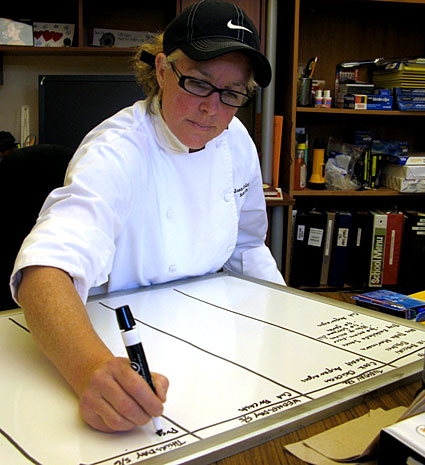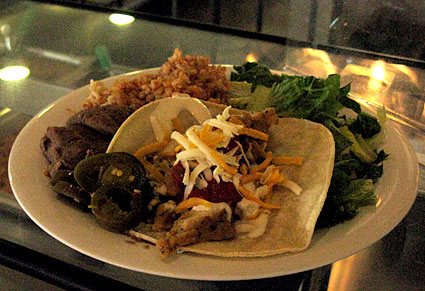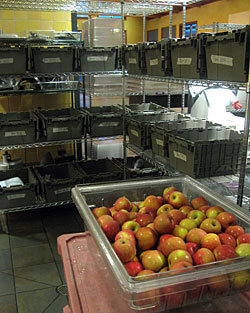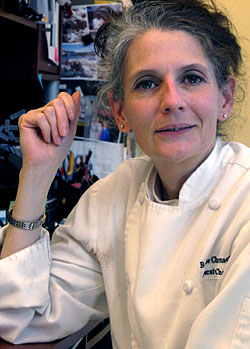Part 3 of Cafeteria Confidential: Berkeley, in which Ed Bruske reports on his recent week-long, firsthand look at how Berkeley, Calif., schools part ways from the typical school diet of frozen, industrially processed convenience foods. Cross-posted from The Slow Cook. And check out the rest of the Cafeteria Confidential series.
 Berkeley Public Schools Executive Chef Bonnie Christensen(Ed Bruske photos)Executive chef Bonnie Christensen was at her desk, holding forth on her troubles with labor unions, when her second-in-command, sous chef Joan Gallagher, walked into the kitchen office cradling a bunch of asparagus freshly picked and just arrived in a 350-pound delivery from Full Belly Farms, some 90 miles northeast near Sacramento.
Berkeley Public Schools Executive Chef Bonnie Christensen(Ed Bruske photos)Executive chef Bonnie Christensen was at her desk, holding forth on her troubles with labor unions, when her second-in-command, sous chef Joan Gallagher, walked into the kitchen office cradling a bunch of asparagus freshly picked and just arrived in a 350-pound delivery from Full Belly Farms, some 90 miles northeast near Sacramento.
Asparagus was entering peak season in California. Christensen and Gallagher planned to serve it in the Berkeley Unified School District school lunches the following week — a rare treat, since asparagus is otherwise cost-prohibitive.
Gallagher regarded the bundle of green spears with a smile and a kind of dreamy, beatific look, as if she were holding a newborn child. During my week working in Berkley’s central school kitchen, I often saw this expression on Gallagher’s face when some aspect of the cooking process particularly aroused her senses.
She might stop to admire a perfectly roasted chicken thigh, its skin like burnished mahogany. “Isn’t that great?” she’d say with a grin and a kind of awe in her voice. Or she would make a sharp detour into the area where I was peeling big, juicy lengths of fresh ginger root just a few feet from another kitchen worker chopping leafy fresh cilantro. The air was pungent with the mingling aromas of what would become a tandoori chicken marinade. “I just love the smell!” Gallagher would exclaim. “I just love it!”
Now she was regarding a bunch of fresh asparagus as if it were the first asparagus ever picked. She was transported. “Isn’t this great?” she said, cradling the asparagus, a smile playing on her face.
Christensen whisked herself in her rolling office chair to the spot where Gallagher was standing. A rapid huddle ensued over how best to prepare the asparagus to feed some 2,350 students at lunch six days hence. They would roast it, no question. But what sort of pan to use? A flat sheet pan? Or perhaps something deeper? How would they trim those 350 pounds of asparagus? How much of the stem end was edible?
Christensen broke off the end of one of the spears and bit into it. She chewed and considered, looking at the ceiling. Was it tough? Would those ends need to be removed? If so, by how much?
Her eyes suddenly lit up. “This is really fresh!” she declared. “I don’t think we need to cut much at all.” Okay, so when to do the cutting? Should they start prepping the asparagus now, on Friday, to sit in the refrigerator over the weekend? “I say don’t even cut them,” Christensen decided. “We’ll cut them next week.”
As quickly as it had started, the discussion was over. But it dawned on me that I had just witnessed something extremely rare: a meeting of the minds between two highly seasoned chefs over a question about how to cook school food.
This is not at all how most school meals are prepared. At my daughter’s elementary school in the District of Columbia, most of the meal components arrive frozen and pre-cooked based on a menu prepared by a nutritionist working in an office for Chartwells-Thompson, a huge, national school food service company that’s just one division of an even bigger, international food service conglomerate based in the United Kingdom — the Compass Group — that’s listed on the London stock exchange.
There now exist computer programs that allow food service administrators to easily create menus that comply with all of the various standards that govern the federally subsidized school meal programs. Corporate food processors also play an oversized role. They’ve developed meal components — those famous chicken tenders, tater tots, and breakfast pizzas — that specifically comply with federal nutrition requirements and prescribed serving sizes.
It all comes together in a system designed to eliminate complicated thinking and to a great extent, any raw products school kitchen workers might have to deal with. It’s the edible equivalent of a simple, paint-by-numbers set with water colors you might buy at a toy store.
The central school kitchen in Berkeley, by contrast, is the rare exception. There, food is cooked the old-fashioned way using raw, not processed, ingredients that must be transformed into meals on a grand scale every day. The only way to do that is with experienced chefs. Although they too must comply with all the federal rules — and live within a school budget — their overriding concern is what they call “the plate.” In the world of chefs, cooking is not just about meeting government standards or providing a prescribed number of nutrients. “The plate” is how chefs express culinary craft as something customers — in this case schoolchildren — will really want to eat. Think of a seasoned artist standing before a blank canvas with a palette of oils.
The magic Christensen
“I hate to say bad things about nutritionists,” says Ann Cooper, nicknamed “Renegade Lunch Lady” for her instrumental role in transforming school meals in Berkeley from frozen, industrially processed convenience food into fresh food cooked from scratch. “But most nutritionists don’t know anything about cooking.”
This particular Berkeley edible artist, Bonnie Christensen, grew up in New York City and started working with food at age 13 in a sandwich shop on Block Island. She put herself through Mount Holyoke College cooking in a hotel restaurant, and moved from there to a degree from the Culinary Institute of America. Christensen thrived in the sweaty, noisy, physical atmosphere of top-flight New York restaurant kitchens, where she was always the only woman. A petite 110 pounds, but with a personality sharp as carbon steel, she managed to hold her own with the boys. “I grew up in the city, so I could deal. I just loved it,” she says. “The adrenaline — that was it for me. One time I had pneumonia and didn’t know what it was. I could barely drag myself off the subway to get to work. But the minute I entered the kitchen and started working, the adrenaline kicked in. There just isn’t time to think. It goes so fast, and you just have to do your job on the line. There could be some guy passed out on the floor from a heroin overdose; you’d just step around him and keep going.”
Christensen accumulated fine dining creds at some of the city’s best restaurants — Gotham Bar & Gill, Le Bernadin, Aureole — at one point working side-by-side with one of the city’s brightest stars, Charlie Palmer. She was plating tender sea scallops served between Palmer’s signature lacy potatoes with citrus sauce, or black bass with mushrooms and lemon confit. She still remembers a hanger steak marinated in dry rub for several days, then cooked rare and dressed with a red wine sauce: “I just thought that was the greatest fun, everything being so perfect and having to be so fast.”
She was lured to a restaurant called Splendido in San Francisco, met her husband on a blind date (“I tried to get out of it”) and continued to work furiously 70 hours a week even after giving birth to a son. “I’d be pumping breast milk in the ice cream room,” she recalls.
But for her second pregnancy, Christensen’s doctor ordered her off her feet. She didn’t work for eight years, instead volunteering at her son’s school until she “got tired of picking lice out of other kids’ hair, and the other parents treating me like the help.” She turned to the job ads on Craigslist, where she found an opening for sous chef at the Berkeley central kitchen that was last in the listings. The ad said: “Sous chef to help make healthy, delicious school meals.”
Ann Cooper, who was running the kitchen at the time, thought Christensen, at 41, was too old. “I said, ‘Ann, my problem isn’t age. My problem is having too much energy!” Christensen moved into the executive chef position when Cooper left for an even bigger challenge — transforming school food in Boulder, Colo.
 Berkeley Public Schools Sous Chef Joan Gallagher prepares the menu.(Ed Bruske)Berkely’s current sous chef, Joan Gallagher, a California native, had previously studied physiology and signed on with what was then a U.S. Department of Agriculture nutritional station at the Presidio in San Francisco. Her job was to study how the human nervous system reacted to Vitamin B6 deficiency. She realized what she really wanted to do was cook.
Berkeley Public Schools Sous Chef Joan Gallagher prepares the menu.(Ed Bruske)Berkely’s current sous chef, Joan Gallagher, a California native, had previously studied physiology and signed on with what was then a U.S. Department of Agriculture nutritional station at the Presidio in San Francisco. Her job was to study how the human nervous system reacted to Vitamin B6 deficiency. She realized what she really wanted to do was cook.
“I was always fascinated by food,” Gallagher says. “It sustains us, but it’s also a beautiful thing. What do people do when they want to be together? They gather over food.”
She met her husband in culinary school. She had restaurant jobs and an externship in the Alsace region of France where she learned about making sausage and charcuterie. They moved so she could run food services in a cafe on the Microsoft campus outside Seattle, supervising 38 employees and making 2,000 meals each day. But they grew homesick for California and came back. She met Christensen because her son and Christensen’s daughter took tap dancing lessons together at the local Catholic school. Christensen was the one with a fresh copy of the New York Times under her arm.
Getting creative with commodities
Together, they perform a job that cannot be done by a computer. “Chefs have to be creative, they have to adapt to whatever set of circumstances arises,” says Christensen. “The very nature of cooking with perishable ingredients requires urgency. Decisions have to made quickly, problems have to be resolved immediately. The stakes are high because food and labor are so expensive; you have to work disciplined, creatively, and within specific boundaries. You are constantly being forced to think outside the box under lots of pressure.” (Christensen writes about these challenges herself in a guest post for my blog, The Slow Cook.)
Of the school district’s 9,178 students, 25.6 percent eat the lunch provided under the federally subsidized school meal program. Nearly 70 percent of the lunches served go to students who are eligible for free or reduced-priced meals based on family income. In addition, the central kitchen prepares 5,590 breakfasts and 1,327 snacks. Christensen and Gallagher are also responsible for 1,097 breakfasts, lunches, and snacks for the school district’s child care program.
The chefs are under pressure to entice children to select the federally subsidized meals, not only to earn the money the U.S. Department of Agriculture pays for each meal (currently $2.68 for a fully subsidized lunch), but also because each meal taken earns the schools credit — about 20 cents — toward purchasing government commodity products. Christensen uses the credits to buy the more expensive raw items on the government’s commodities menu, such as chicken and beef, but also pasta noodles and canned tomatoes for sauces.
Except that she never knows how good the meats will be. “They offload garbage to the schools,” Christensen says. “I’ve gotten chicken that was frozen from such a rotten state, it would glow in the dark. The diced chicken is so freezer burned, making it edible is a work of art. And we can’t send it back. Once you’ve ordered it, it’s yours.”
Under the Berkeley system, the central kitchen where Christensen and Gallagher are in charge makes most of the food served in all the district’s 16 schools. The other schools employ workers who reheat and serve the food. The central kitchen scheme avoids having to put a production kitchen with skilled staff in every school. But it does place a heavy burden on Christensen and Gallagher.
Labor is an issue. About 60 percent of Berkeley’s food budget is devoted to labor and overhead. But the kitchen staff essentially is unskilled, and according to Gallagher, paid less than custodial workers. They require constant supervision and direction. “It’s hard, physical work,” she says.
 Beef “fajitas” made from chuck roast.(Ed Bruske)One day I watched Gallagher engage in a long and detailed discussion with one of the kitchen workers — Roxanne — about how to break down 200 pounds of U.S. commodity beef shoulder meat and turn it into the fajitas advertised on school menu for Thursday’s lunch. Shoulder, or chuck, is not the usual cut of meat used for fajitas — that would be skirt or flank steak. But Gallagher used a series of hand motions to show Roxanne how she thought the meat could be divided into a series of mini-roasts for cooking in the kitchen’s convection ovens. It would then be pulled apart while still hot by Roxanne and another worker wearing a triple layer of gloves, then mixed with sauteed onions and seasonings. (The result was not anything like the fajitas I’m used to — more like pot roast served with corn tortillas. But I love pot roast, and Gallagher’s version was outstanding.)
Beef “fajitas” made from chuck roast.(Ed Bruske)One day I watched Gallagher engage in a long and detailed discussion with one of the kitchen workers — Roxanne — about how to break down 200 pounds of U.S. commodity beef shoulder meat and turn it into the fajitas advertised on school menu for Thursday’s lunch. Shoulder, or chuck, is not the usual cut of meat used for fajitas — that would be skirt or flank steak. But Gallagher used a series of hand motions to show Roxanne how she thought the meat could be divided into a series of mini-roasts for cooking in the kitchen’s convection ovens. It would then be pulled apart while still hot by Roxanne and another worker wearing a triple layer of gloves, then mixed with sauteed onions and seasonings. (The result was not anything like the fajitas I’m used to — more like pot roast served with corn tortillas. But I love pot roast, and Gallagher’s version was outstanding.)
Christensen said success of the operation rises or falls on the menu. In addition to spelling out the food that will be served, it must take into account numerous moving parts: food costs, budget, available labor, skill level, and of course, all of the innumerable government standards that apply to the school meal program. For instance, the Berkeley schools operate under something called the “enhanced” meal plan published by the USDA.
The plan requires that students be offered at least 11 portions of grains each week. That’s a lot of starch. But instead of putting it all on kids’ plates, as Jamie Oliver famously was told to do in his Food Revolution series — he thought the standards were crazy — the Berkeley kitchen has devised a clever strategy: not only is there grain in, say, the pizza crust, there’s a soup station, separate from the food line, where the soup always has a noodle or some other grain product in it. They also include the croutons at the salad bar, made by a local company from day-old, whole-grain bread roasted with olive oil.
Turning curveballs into home runs
While I was in Berkeley, Christensen was working on a fifth draft of the entire menu for the school year that would begin in the fall. She’s learned to keep a weekly schedule: pizza on Mondays; Tuesday chef’s choice (hamburger, hot dog, meat loaf, etc.); Wednesday is pasta; Thursday, chicken or turkey; Friday, Mexican. She has lists of entrees for each category, but they all have to work within the budget and with the available labor pool — and adjust for holidays and seasonal foods that might suddenly appear in the market.
On Fridays, Gallagher sits down with the menu and a dry-erase board and creates “prep lists” for each day of the week, tasks that need to be performed to get the food ready. But there are frequent curveballs. Once, delicata squash was listed on the menu. It sounded like a good idea, but cutting through the tough skins to get the squash ready for cooking proved problematic. “It took four people working eight hours to cut up all that squash,” Gallagher said. “And then the kids didn’t eat it.”
They often serve local, grass-fed beef hot dogs with fresh-cooked beans in a homemade barbeque sauce. But when four of the kitchen crew called in sick, there was no one to make the beans. They had to dip into their store of canned beans.
Frozen commodity chicken will stay frozen even when it’s not in the freezer if the boxes are all stacked together. But one week someone took the chicken out of the boxes too soon. There was a scramble to come up with a plan for hundreds of pounds of suddenly defrosting, raw chicken. They put it in a brine to preserve it and impart additional flavor until they were ready to use it.
On another occasion, 25 cases of cauliflower arrived only half the usual size. “But they had all these wonderful, leafy greens on them,” Gallagher said. “So we julienned and sauteed all the greens and served them with the cauliflower. It was fantastic.”
Frozen tamales from a local purveyor were a good deal. But they came 4,800 to a pallet, more than the schools can use in any one meal. What to do with the rest? Where to store them?
They added cream cheese to the macaroni and cheese to make it creamier, but then it wasn’t orange enough. So they added turmeric, a spice common in Indian cuisine with a potent orange color that gives curry powder its distinctive hue. It also happens to be a healthy anti-inflammatory.
 Kid-size apples in the walk-in.(Ed Bruske)Elementary schools complained the kids never had enough time to eat lunch. The chefs realized there were too many food items on the plates, which meant kids waited in long lines. They streamlined the menu. Likewise, offering three different entree options at the high school proved to be too expensive and created too much waste. They pared it back to two.
Kid-size apples in the walk-in.(Ed Bruske)Elementary schools complained the kids never had enough time to eat lunch. The chefs realized there were too many food items on the plates, which meant kids waited in long lines. They streamlined the menu. Likewise, offering three different entree options at the high school proved to be too expensive and created too much waste. They pared it back to two.
The chefs deal not just with the often finicky tastes of school children, but the sometimes enervating demands of parents. “I spent 45 minutes on the telephone with one mother who wanted to know why the kids can’t have two egg rolls instead of vegetables or two slices of pizza,” said Christensen. “I have to explain to her that we’re trying to introduce healthy food.”
Most schools routinely serve apples that are so big, kids take a couple of bites and are through with them. The partially eaten apples end up in the trash. Berkeley schools found a local orchardist who saves all his small apples that won’t sell commercially, but are a perfect size for children.
Figuring out how to make 1,000 pounds of pasta for pasta days was trickier. “We sell so much pasta, we could serve it every day and the kids would be fine with it,” Christensen said. “We used to do only two pasta dishes — with marinara sauce, and macaroni and cheese. That was a tough part of my job, coming up with more pasta recipes.”
Christensen said there’s no equipment in the kitchen designed to cook that much pasta. But she devised a method. Except the 110-pound chef has to stand on a plastic milk crate to lift the basket she uses to cook the pasta in the kitchen’s giant kettle cooker. “I can do it really quickly. I’ve kind of mastered it,” she says.
Next: How Berkeley has cleverly created a universal free breakfast that subsidizes lunch.




